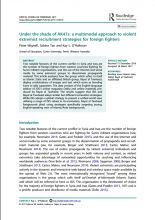Two notable features of the current conflict in Syria and Iraq are the number of foreign fighters from western countries fighting for Sunni militant organisations, and the use of the Internet and social media by some extremist groups to disseminate propaganda material. This article explores how the group which refers to itself as Islamic State and an affiliated British group, Rayat al Tawheed, deploy combinations of images and text which serve as bonding icons to rally supporters. The data consists of the English language edition of ISIS’s online magazine Dabiq and online materials produced by Rayat al Tawheed. The results suggest that ISIS and Rayat al Tawheed adopt similar but different iconisation strategies. While ISIS adopts a global strategy to present a unified world view utilising a range of ISIS values in its iconisation, Rayat al Tawheed foregrounds jihad using strategies specifically targeting young, English-speaking men of Islamic/Arab backgrounds.
